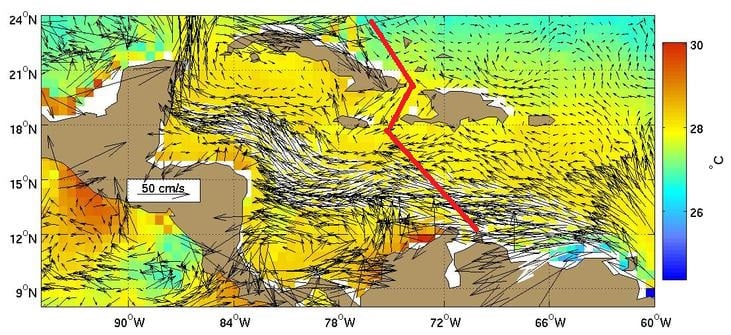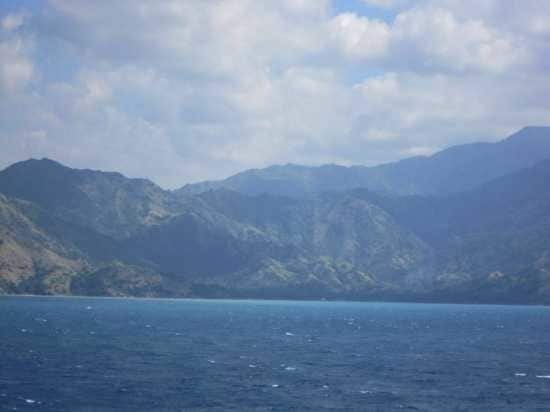Today we had the first of one and half sea days to cover the distance between Half Moon Cay and Oranjestad in Aruba. Early this morning we sailed into the Windward Passage, the gap between the East point of Cuba and the West point of Hispaniola, or in the same way, between Cabo Maisi and Haiti. Then by noon time we cleared the Haitian coast and entered the Caribbean Sea. There was a lot of cloudiness obscuring the sun this morning and that spoiled the sail by near Haiti a little bit. If the sun can casts its rays un-obstructed into the sea then in this area you can see the sea bottom very clearly.
Sometimes to such an extent that it worries the guests who think that we are in very shallow waters. But we stay about 4 miles off the coast and the water is at least 60 to 100 feet deep under the keel on the route that we follow. But as the water is so clear and the bottom consists out of fine white sand, you can see the sandy sea bottom well over 60 feet down. I always tell guests who are asking about stabilizers on a day like this, to look over the side near lifeboat 7 and 8 when we are in this area, and then they can see them in operation. Not very exciting as it just looks like a stubby air plane wing painted in a red color. By they do their job and that is what it is all about.
I mentioned that the weather in Carib has been very boisterous in the last few days and although it has quieted considerably, the seas are still a bit confused. For a while a North Westerly wind had been blowing around here and now the regular trade wind is returning and is blowing the other way. Which causes the waves to come from two directions and result in a short wave / choppy sea.

Our route into the Caribbean. The density of the arrows give the strength of the current. Problem is that it is never the same so you cannot rely on a diagram like this to get it completely right.
For this run, the captain really has to calculate the miles and the most advantageous courses to steer as we come across some opposite winds and currents. While sailing down from Half Moon Cay we have a small current against us, then before we enter the Windward Passage we get it on the beam and then when entering the Passage we can get up to 2 knots with us and sometimes a push from the wind as well.
Then while sailing off the Haitian coast there is nothing, but once we are clear we get the N.E current in the open Caribbean Sea generated by the Trade Winds. That current is in the beginning sort of with us and then later sort of against us as we are sailing on a South Easterly course. The art of navigating is to figure out roughly (Navigation is an art, not a pure science as we are dealing with the ever changing behavior of Mother Nature) what to expect in current velocity with us and against us and see if we can offset the one against each other. It is always satisfying to arrive at Aruba and to see that the ship had been able to maintain the average speed needed without having to change the engine configuration to catch up and to avoid being late.
So going from HMC until this evening we went faster than we needed on the average, but tonight we might go a little bit too slow, then late tomorrow morning we will pick up some current again and that altogether should bring us exactly on time at the Oranjestad Pilot station, by noon time. Sometimes Mother Nature is not predictable and then we have to adjust. Sometimes we go too fast (That is a bonus, as we save fuel) sometimes we go too slow and we have to give the ship an extra kick on the engines to compensate.
But with average weather and average sea conditions it quite often works out the way it is planned.
Tomorrow we have half a day at sea, and if the weather does what it is supposed to do (follow the weather forecast) then we should have a regular Caribbean Sea day. With the Trade wind blowing over the port bow and a regular low swell coming from the East. But whatever the weather, it will be warm. Even the rain if it falls.


February 10, 2018 at 12:15 pm
Captain A,
Welcome back. Last year you did a story on visiting a lady who had an antique barometer or clock that I believe you sent to a museum back home to have it studied. Do you have a status update that you could give us?
Looking forward to three months of blogs.
Regards,
Roger T
February 11, 2018 at 6:37 pm
Hi Captain Albert:
A belated “welcome Back”. Looking forward to your enlightening daily blogs !
Ruud Hartog